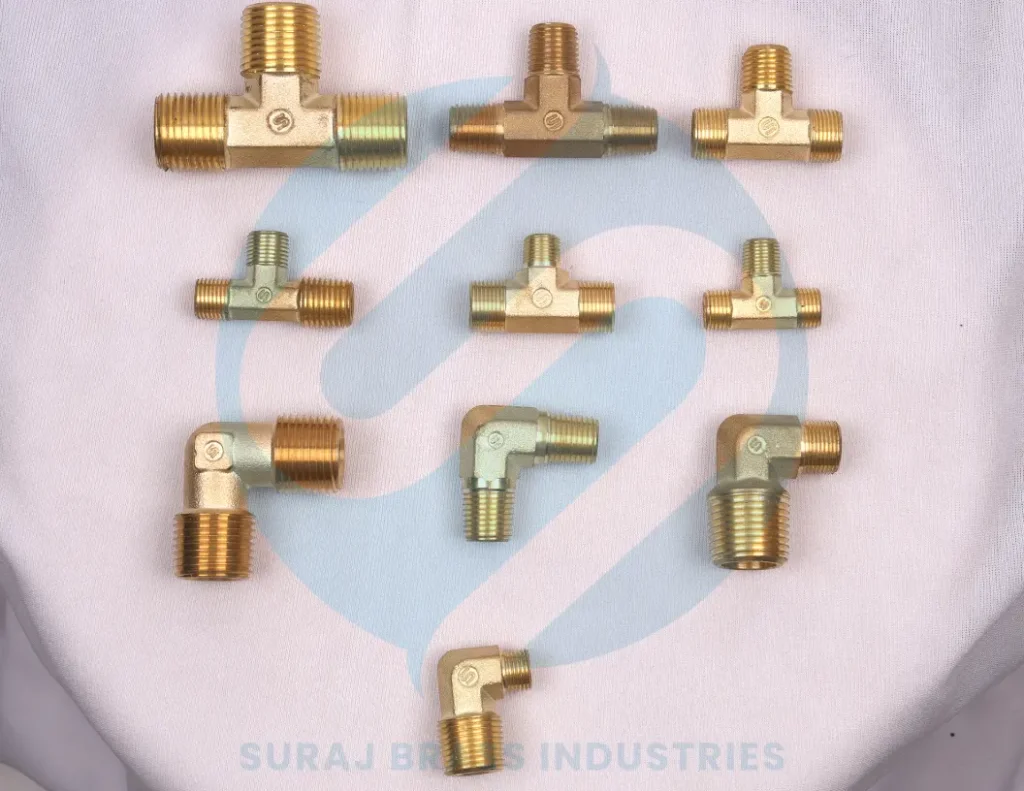In plumbing, HVAC, and other industrial works, choosing the right fitting can greatly determine the quality of the work, such as the tools used. That makes Brass Tees fittings the perfect solution! It allows three piping sections to be connected and enables the flow of liquids or gas in various directions. Not only do brass tees provide utility, but they also exhibit tremendous strength, are simple to use, and are corrosion resistant. Thus, they are very useful in areas where durability and precision are crucial.
In today’s topic, we would like to shift how simpler T-shaped brass pipe fittings are compared to other more intricate fittings like stainless steel, copper, PVC, iron pipes, and even Teflon valves. By the end of the discussion, you will understand why various industries prefer brass tee fittings.
Understanding Brass Tees
Brass tees are T-shaped fittings that connect three sections of a piping system. They have two straight and one right-angled connection. These fittings are made from a combination of zinc and copper, which contributes to their incredible corrosion resistance and notable strength.
Common brass tee applications include:
- Plumbing and Water Supply
- HVAC Systems
- Automotive and Marine Applications
- Industrial Fluid Distribution Systems
Brass is a plumbing material of choice due to the extreme pressure and temperature changes they endure; their reliability in these conditions is unmatched. Our brass tee fittings undergo precise machining with a uniform thickness design to improve their performance while minimizing the chance of leaks.
Overview of Other Common Fitting Materials
Fittings are made from various materials, and they all offer certain advantages.
1. Stainless Steel Fittings:
- Highly corrosion-resistant and durable.
- Designed for high-temperature and pressure applications.
- Higher cost than most others.
2. Copper Fittings
- Great corrosion resistance, excellent thermal conductivity.
- This product is very popular in plumbing and HVAC.
- Softer metal compared to brass, therefore not suitable for high-impact applications.
3. PVC (Polyvinyl Chloride) Fittings
- Failsafe for residential plumbing and irrigation.
- The product is very economical and lightweight.
- Require fitting and high durability under pressure and extreme temperatures.
4. Iron Fittings
- Very strong and robust, commonly used in drainage and wastewater systems.
- Without protection, the material is highly prone to rust.
Key Factors to Consider When Choosing Fittings
It is crucial to consider a number of factors when selecting a fitting material to ensure it performs exceptionally.
1. Durability and Longevity:
Brass is unmatched in durability, granting suitability for both low and high-pressure systems. It is superior to most alternatives in terms of wear, impact, and environmental conditions.
2. Corrosion Resistance:
Brass tee caters are better suited than copper or iron fittings for water and marine applications due to their natural rust and corrosion resistance.
3. Strength and Pressure Handling:
Brass is flexible enough to withstand a considerable amount of force while being strong enough to not break in the process.
4. Cost-Effectiveness:
Brass fittings are highly cost-effective due to their durability and low maintenance, giving them a long-term savings return. Even if stainless steel fittings are stronger, they are more costly.
5. Ease of Installation:
Brass fittings are easy to install due to their lightweight, unlike PVC or iron fittings, which require complicated adhesives.
Brass Tees vs. Other Fittings: A Comparative Analysis
| Feature | Brass Tees | Stainless Steel | Copper | PVC | Iron |
| Durability | High | Very High | Moderate | Low | High |
| Corrosion Resistance | Excellent | Excellent | Good | Excellent | Low |
| Cost-Effectiveness | High | Moderate | Moderate | Very High | Moderate |
| Ease of Installation | Easy | Moderate | Easy | Moderate | Difficult |
| Strength and Flexibility | Balanced | Very High | Moderate | Low | High |
Why Brass is the Best Choice for Your Projects
Choosing brass tee fittings gives you several advantages:
- Long-Term Durability: Great for residential and industrial use.
- Corrosion Resistance: Performs wonderfully in water and marine applications.
- Cost-Effective: Less funding for maintenance in the long run compared to other materials.
- Customizable sizes and designs: We design solutions to meet specific project requirements.
- Eco-friendly: Recyclable brass contributes to sustainable practices.
Exploring the Varied Uses of Brass Tees
Applications of Brass Tees Across Different Industries
1. Plumbing and Water Supply:
Residential and commercial plumbing systems require water distribution fittings, and brass fittings ensure proper flow.
2. HVAC Systems:
They are also useful in heating, ventilation, and air conditioning systems to control fluid and gas movement at extremely high temperatures.
3. Automotive and Marine:
Withstanding corrosion makes strong brass components useful in fuel systems and marine equipment.
4. Industrial Applications:
Brass tees are essential for manufacturing plants and chemical processing industries because they require fluid distribution systems that are durable and dependable.
FAQs: Brass Tee Fittings
Q1: Why Are Brass Tee Fittings Preferred Over Other Materials?
Brass is the best option because it is durable, cost-effective, and resistant to corrosion. Its performance improves in high-pressure and high-temperature conditions.
Q2: Can Brass Tees Be Used in HVAC Systems?
Definitely! Because of their resistance to corrosion and ability to withstand temperature changes, brass tees are perfect for HVAC systems.
Q3: Are Custom Brass Tee Fittings Available?
Definitely! Here at Suraj Brass Industries, we pride ourselves on sourcing custom brass tees for different projects.
Conclusion
For reliability and economy, there are no better fittings than brass, and their usage is vast. They are unmatched in durability, versatility, corrosion resistance, plumbing, HVAC, and industrial projects.
For premium brass tees, look no further than Suraj Brass Industries. Years of experience in the market mean products that not only meet international standards but also exceed customer satisfaction.
📞 Contact Us: +91-9227022044
🌐 Visit Us: Suraj Brass Industries

